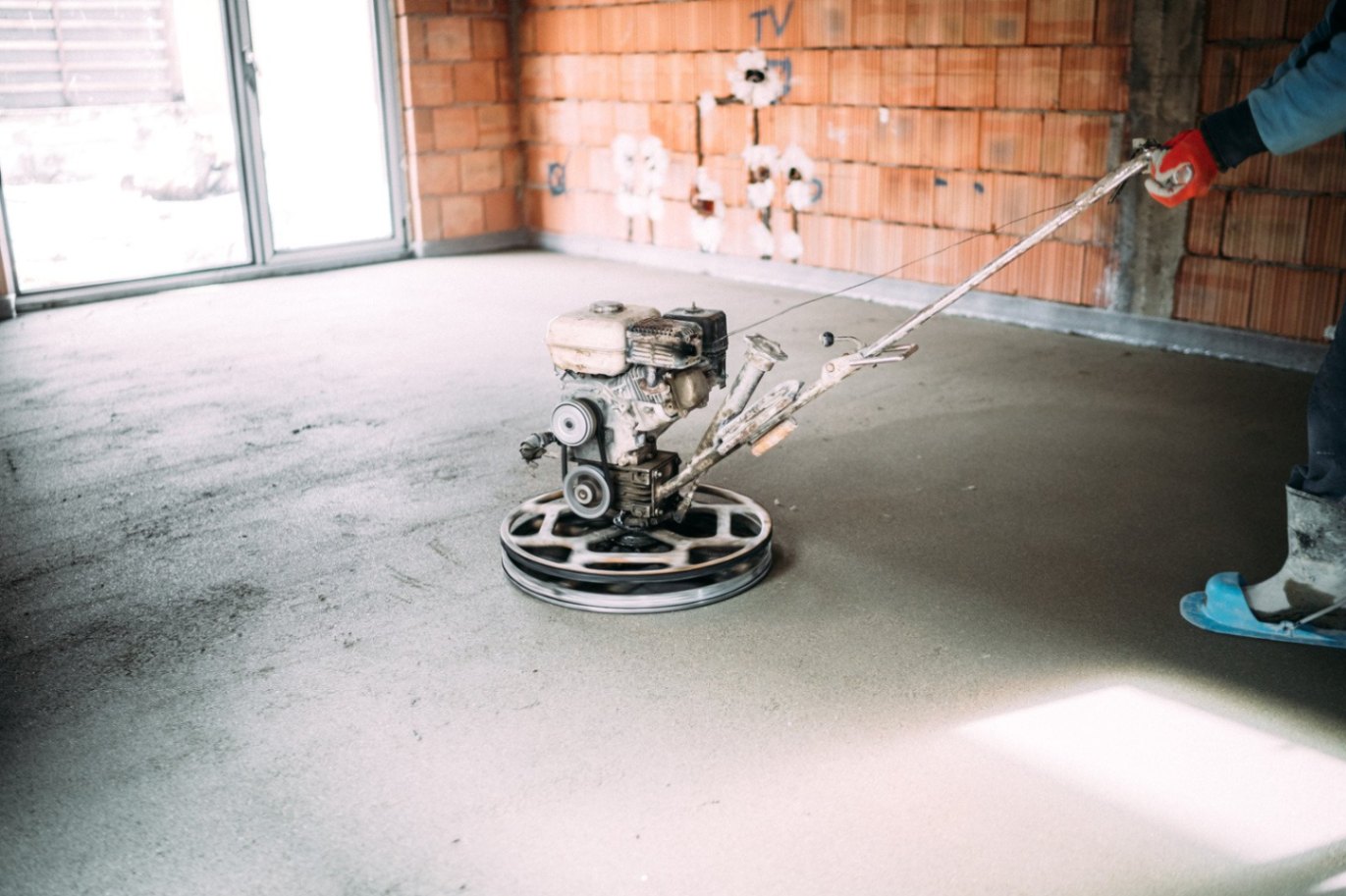When it comes to concrete finishes, choosing the right one for your project involves more than just aesthetics. Each finish offers unique benefits, from durability to slip resistance. Whether you’re looking for a sleek polished surface or the rustic appeal of exposed aggregate, understanding your options is essential. The right choice can improve functionality while complementing your design vision. Let’s explore the various finishes available and how they might fit your specific needs.

Key Takeaways
- Determine your aesthetic goals: choose polished concrete for modern elegance or textured finishes like exposed aggregate for a rustic appeal.
- Assess the project’s location: polished concrete is suitable for high-traffic indoor areas, while textured finishes excel outdoors for safety and durability.
- Consider maintenance requirements: polished concrete requires periodic resealing, while broom-finished and exposed aggregate options are low maintenance and easy to clean.
- Evaluate durability needs: acid-stained concrete and overlay finishes enhance appearance while improving surface longevity, making them ideal for high-traffic areas.
- Explore customization options: stamped concrete offers extensive design flexibility, allowing you to mimic natural materials or create unique patterns for your project.
Understanding Concrete Finishes
Concrete finishes play an essential role in both the aesthetics and functionality of a surface. To achieve the desired results, you must prioritize surface preparation. Properly preparing the concrete substrate guarantees ideal adhesion for the chosen finish. This process involves cleaning, leveling, and repairing any imperfections.
Once prepared, you can focus on finish selection, which impacts both appearance and durability. Common options include stamped, broom, and troweled finishes, each offering unique textures and visual effects.
Consider the intended application and environment when making your choice, as this will influence performance over time. By carefully executing surface preparation and thoughtfully selecting your finish, you can improve both the look and longevity of your concrete project.
Polished Concrete: A Sleek Option
Polished concrete offers a modern aesthetic that improves any space with its sleek finish.
You’ll appreciate its low maintenance requirements and impressive durability, making it a practical choice for high-traffic areas.
Understanding the installation process is essential to achieving the best results and ensuring longevity.
Appearance and Aesthetics
A sleek surface can convert any space, and polished concrete is an excellent choice for achieving a modern aesthetic. This finish offers a refined look, enhancing both residential and commercial environments.
You can select from various color trends to match your design vision, whether you prefer subtle earth tones or vibrant hues. Additionally, polished concrete allows for multiple texture options, ranging from a high-gloss shine to a softer, satin finish.
These aesthetic choices enable you to create a customized appearance that complements your space’s overall style. By choosing polished concrete, you’re not only opting for a visually appealing surface but also a versatile one that can adapt to various design elements and trends.
Maintenance and Durability
Choosing polished concrete not only improves the visual appeal of your space but also provides significant advantages in maintenance and durability.
This flooring option is remarkably resilient, requiring minimal long-term care compared to traditional surfaces. With proper surface protection, such as periodic resealing, you can easily maintain its luster and prevent staining. Regular sweeping and occasional mopping with a pH-neutral cleaner will keep your polished concrete looking pristine.
Additionally, its resistance to moisture and abrasions makes it ideal for high-traffic areas, ensuring longevity. By investing in polished concrete, you’re choosing a low-maintenance solution that withstands the test of time while enhancing the aesthetic of your environment.
Prioritize surface protection to maximize its durability and visual appeal.
Installation Process Overview
When considering polished concrete for your space, it’s vital to understand the installation process, as it sets the foundation for both aesthetics and functionality.
The first step involves thorough surface preparation, which includes cleaning, repairing cracks, and leveling the concrete to guarantee a smooth base.
Next, you’ll select appropriate installation techniques, such as grinding and polishing with varying grit levels to achieve your desired sheen.
Using specialized equipment, skilled contractors will progressively refine the surface, enhancing its durability and appearance.
Finally, applying a sealer will protect the polished finish and improve longevity.
Each phase is significant; proper execution guarantees a stunning, functional polished concrete floor that meets your project’s requirements.
Exposed Aggregate: Rustic Charm
Exposed aggregate concrete offers a unique aesthetic appeal with its textured surface, revealing stones and pebbles that create a rustic charm.
However, it’s crucial to evaluate maintenance requirements, as this finish can accumulate dirt and debris over time.
Understanding both its beauty and upkeep will help you make an informed choice for your space.
Aesthetic Appeal
Although many concrete finishes offer unique looks, exposed aggregate stands out for its rustic charm and visual appeal.
This finish reveals a variety of textured patterns, showcasing the natural beauty of the aggregate stones beneath the surface. You can customize the look by selecting different aggregates, providing a range of color variations that improve your project’s aesthetic.
The result is a visually striking surface that complements both modern and traditional designs. Exposed aggregate not only adds character but also creates a slip-resistant texture, making it suitable for outdoor spaces.
Whether you’re considering a patio, driveway, or walkway, this finish can elevate your project while providing a durable and attractive surface.
Maintenance Considerations
Maintaining the rustic charm of exposed aggregate requires specific attention to its unique surface characteristics. To preserve its appearance, you should adopt effective cleaning techniques.
Regularly sweep or use a leaf blower to remove debris. For deeper cleaning, a pressure washer with a mild detergent works well, but be cautious not to erode the aggregate. Avoid harsh chemicals that can damage the surface.
Additionally, consider applying a sealant specifically designed for exposed aggregate. This provides surface protection, shielding against stains and wear while enhancing the texture.
Reapply the sealant every few years, depending on your climate and usage. By following these maintenance practices, you’ll guarantee your exposed aggregate retains its appeal and functionality for years to come.
Stamped Concrete: Versatile Designs
When you’re looking to improve the aesthetic appeal of your outdoor spaces, stamped concrete offers an array of versatile designs that can mimic natural materials like stone, brick, or tile.
This finish provides exceptional design flexibility, allowing you to tailor the appearance to match your specific project needs. You can choose from various patterns, colors, and textures, ensuring that your outdoor space reflects your personal style.
Stamped concrete also allows for significant project customization, as you can incorporate unique patterns and borders that boost visual interest. Its durability makes it an attractive option for high-traffic areas, combining beauty and functionality.
With stamped concrete, you can achieve a stunning look that stands the test of time.
Broom Finished Concrete: Practicality Meets Function
Broom finished concrete is a popular choice for surfaces that require both durability and slip resistance, making it ideal for driveways, sidewalks, and patios.
This technique involves dragging a broom over freshly poured concrete, creating a textured surface that improves grip. The resulting broom texture effectively minimizes the risk of slips, especially in wet conditions, ensuring safety for pedestrians and vehicles alike.
Additionally, the finish is low maintenance; it can withstand heavy foot traffic and weather elements without significant wear. You can easily clean it with a hose or power washer, maintaining its appearance and functionality.
With its blend of practicality and effectiveness, broom finished concrete is a smart choice for any project prioritizing safety and durability.
Acid Stained Concrete: Adding Color and Depth
Acid stained concrete alters ordinary surfaces into vibrant works of art, offering a unique aesthetic that improves both residential and commercial spaces. This technique uses a chemical reaction between acid-based solutions and the minerals in the concrete, resulting in stunning color variations.
Each application is distinctive, creating a rich depth that boosts the overall appearance. You can choose from various staining techniques, including single and multi-tone applications, to achieve your desired effect.
The process not only adds visual appeal but also protects the concrete, making it more durable. Acid stained concrete is ideal for patios, floors, and walkways, allowing you to customize your space while enjoying the long-lasting benefits of this innovative finish.
Overlay Finishes: Revitalizing Existing Surfaces
If you’re looking to breathe new life into worn or damaged concrete surfaces, overlay finishes offer an effective solution.
These finishes utilize advanced overlay techniques to create a fresh, durable layer that improves both appearance and functionality. Proper surface preparation is essential; verify the existing concrete is clean, free of contaminants, and structurally sound.
This may involve repairing cracks and filling voids before applying the overlay. You can choose from various overlay types, including stampable, spray, or self-leveling options, each suited for different aesthetic goals and usage scenarios.
Frequently Asked Questions
How Do I Maintain Different Types of Concrete Finishes?
To maintain different concrete finishes, you should apply appropriate sealing techniques regularly and use specific cleaning methods customized to each finish. This guarantees durability while preserving the aesthetic appeal and functionality of your concrete surfaces.
Can I Change My Concrete Finish After Installation?
Yes, you can change your concrete finish after installation. Consider concrete resurfacing options or alternative finish techniques, which can improve aesthetics and durability, allowing you to achieve your desired look and functionality effectively.
What Is the Cost Difference Between Concrete Finishes?
When considering a cost comparison of concrete finishes, you’ll find options vary considerably. For effective budget planning, assess each finish’s material and installation expenses, ensuring it aligns with your overall financial goals for the project.
How Long Does Each Type of Finish Last?
The longevity of each finish varies considerably. Factors like exposure, maintenance, and material quality influence durability. When you compare finishes, consider these longevity factors to determine which option best suits your project’s needs.
Are There Specific Weather Considerations for Concrete Finishes?
Yes, you must consider climate impact and seasonal effects when choosing concrete finishes. Extreme temperatures can affect curing, while moisture levels may lead to scaling or cracking, so select a finish suitable for your local conditions.
Conclusion
To sum up, choosing the right concrete finish depends on your specific project needs and aesthetic preferences. Polished concrete offers a modern, low-maintenance look, while textured options like exposed aggregate and broom finishes provide durability and safety for outdoor areas. Acid staining and overlay finishes can improve visual appeal and protect surfaces in high-traffic environments. By evaluating your goals and requirements, you can select the ideal finish that combines both functionality and style for your project.
